Posts tagged ‘Service’
How to Know When to Replace Forklift Parts
Keeping your forklifts in good shape is crucial for them to work well. This blog will discuss maintaining forklifts, focusing on one part at a time.
Forks
The front part of the forklift, called forks, wears out over time. Replace them when they’ve lost 10% of their thickness or show damage like bending or stress fractures. Have a qualified technician check them thoroughly at least once a year for safety.
Brakes
Check brakes regularly and replace them immediately if they’re not working well, have visible damage, or are worn out. Many manufacturers suggest changing brakes every two years.
Lift Chain
Regularly check the lift chain for damage or stretching. Some manufacturers recommend replacing it every three years or after 6,000 hours of use.
Oil & Air Filters
Change oil and air filters as the manufacturer recommends to keep the forklift’s engine safe from damage and running efficiently.
Tires
Replace forklift tires if you see signs of damage like chunking, tearing, or bald spots. This keeps your forklift safe and compliant with OSHA standards.
Learn more about taking care of your forklift tires.
Fuel Hose for IC Forklifts
Inspect and replace the fuel hose in IC forklifts every two years.
Other Forklift Parts
Through experience, you’ll learn about other parts prone to failure in your forklift fleet. Keep a detailed log to identify and stock spare parts for these items.
If maintaining your forklift fleet isn’t your focus, our team of 60+ certified technicians with over ten years of experience can help. Contact us for forklift repairs and service in Los Angeles County. We also offer rental services if your forklift is out for extensive repairs.
Consider Toyota’s Guaranteed Maintenance Program for planned maintenance, repairs, and breakdowns. Get monthly reports on your truck’s use and costs to help you budget.
Contact us today to improve the longevity and efficiency of your forklift fleet.
Why You Need the Right Forklift Parts
Ensuring your Toyota Forklift’s performance and longevity involves more than maintenance; it hinges on the quality of the spare parts you choose. While forklift parts may seem simple, their impact on performance and efficiency is substantial. In this blog post, we look into the advantages of using Toyota Genuine Parts to maximize the value of your forklift.
The Value of Toyota Genuine Parts
- Unmatched Quality, Durability, and Reliability: Toyota Genuine Parts embodies the same commitment to quality, care, materials, and attention to detail as the forklifts they support. By choosing original parts, you invest in components designed to uphold the renowned Toyota standard.
- Long-term Value: Although the upfront cost may be higher, the long-term value of Toyota Genuine Parts becomes evident through enhanced durability, reliability, and extended lifespan. You’re not just replacing parts; you’re securing an investment in the performance of your forklift.
- Extended Lifespan of Your Forklifts: Genuine parts align with the entire forklift system, promoting longevity and minimizing the risk of unexpected breakdowns. By choosing Toyota Genuine Parts, you contribute to the extended lifespan of your forklifts, reducing the frequency of replacements and associated costs.
- Industry-Leading Warranty Coverage: Toyota Material Handling Solutions stands behind the quality of its Genuine Parts with an industry-leading warranty. Any Toyota part found to be defective under regular use is eligible for replacement or repair within a generous two-year or 4,000-hour timeframe. Significantly, warranty repairs or replacements performed by Toyota Certified Technicians incur no additional charges during this period.
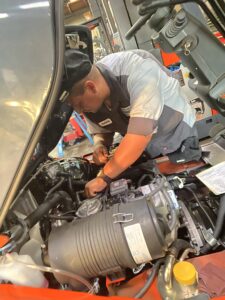
- Optimal Performance and Uptime: Genuine parts complement the intricacies of your Toyota forklift. By choosing these parts, you ensure optimal performance, reduced downtime, and increased overall uptime for your fleet. Toyota Genuine Parts enhances productivity and facilitates a more efficient and streamlined operation.
- Customer Satisfaction: Quick order fulfillment is vital in today’s fast-paced business environment. With Toyota Genuine Parts, you minimize delays, meet customer demands promptly, and safeguard your reputation for timely deliveries.
- Innovation Opportunities: Uninterrupted operations save valuable time for essential tasks and innovations. Investing in genuine spare parts empowers your team to focus on productivity and improvements rather than grappling with downtime-related challenges.
StarLift Program for Mixed Fleets
Through our StarLift Program, Toyota Material Handling Solutions caters to businesses with mixed fleets, offering forks, oils/chemicals, batteries, tires, and other replacement parts. The program ensures compatibility with various manufacturers while maintaining the quality synonymous with Toyota.
Elevate your forklift’s performance, extend its lifespan, and minimize downtime by choosing Toyota Genuine Parts. For inquiries about how these parts can enhance your uptime and overall operational success, contact us at (800) 794-5438 or complete this form. Make a strategic investment in the longevity and efficiency of your material handling equipment with Toyota Genuine Parts.
Watch a video to learn more about Toyota Genuine Parts.
Why You Need Toyota 360 Support
You may have come across the terms Toyota 360 Support and Toyota 360 Support Plus, but understanding the nuances can be perplexing. Fear not! In this blog post, we aim to demystify these plans by answering frequently asked questions to understand what each provides and why it’s essential to productivity.
What is Toyota 360 Support?
At its core, Toyota 360 Support embodies Toyota’s commitment to being your partner throughout the entire lifecycle of your material handling equipment. The lifecycle encompasses the processes of buying, owning, servicing, and eventually replacing the equipment when necessary.
Why is Toyota 360 Support necessary?
Downtime is the adversary, and Toyota 360 Support is your shield. By optimizing the performance of your investments, preventing downtime, and safeguarding your bottom line, this support plan ensures you get the most out of your material handling equipment.
What does Toyota 360 Support include?
Toyota 360 Support has many benefits, including a guaranteed 4-hour response time for emergency service requests and a 2-year warranty on genuine parts—all at no additional cost.
What about the cost of Toyota 360 Support?
Good news! Toyota 360 Support is a standard feature in Toyota’s industry-leading warranty, so there’s no extra cost to you.
Can I still get Toyota 360 Support if I relocate?
Absolutely! Toyota has you covered, regardless of your location. Toyota 360 Support provides access to a vast network of over 3,500 certified Toyota technicians and more than 220 dealer locations nationwide.
What is Toyota 360 Support Plus?
Building upon the foundation of Toyota 360 Support, Toyota 360 Support Plus takes it a step further by offering additional perks, such as the first year of Planned Maintenance (up to 4 PMs), carriage-to-counterweight coverage for up to 3 years or 6,000 hours, and a 5-year major component coverage.
How much does Toyota 360 Support Plus cost?
The cost of Toyota 360 Support Plus varies based on the specific model of your material handling equipment. You can find the pricing details for your model on the Toyota website.
Can I get Toyota 360 Support Plus with T-Matics installed?
Indeed, although there is a slightly higher cost associated with it. Detailed pricing information for specific models with T-Matics installed is available on the Toyota website.
Can I extend Toyota 360 Support Plus beyond three years?
Absolutely! Toyota 360 Support offers 4- and 5-year options for most models. Check the Toyota website to see if an extended plan is available for your specific model.
How much money can I save with Toyota 360 Support Plus?
Savings with Toyota 360 Support Plus are substantial, but the exact amount depends on your specific model. Visit the Toyota website for a value comparison tailored to your equipment.
Is Toyota 360 Support Plus available if my business is far from a Toyota dealership?
Toyota 360 Support Plus pricing and availability apply to customer locations within 50 miles of a Toyota Forklift dealership. Additional charges may apply beyond this distance.
Ready to purchase a forklift with Toyota 360 or Toyota 360 Support Plus?
Contact us to set up a free consultation. Our knowledgeable material-handling professionals can assist you in finding the perfect forklift and 360 Support plan for your specific needs.
Watch a video to learn more about Toyota 360 and 360 Support.
What You Need To Know About Forklift Fork Maintenance
Welcome to our comprehensive guide on forklift fork inspections and maintenance. As an integral component of forklifts, fork maintenance is essential to ensure optimal performance and minimize workplace risks. In this blog post, we delve into the frequently asked questions about inspecting forklift forks, daily checks, and common causes of damage. Whether you’re a forklift operator, warehouse manager, or safety supervisor, understanding these crucial aspects will contribute to a secure working environment and the prolonged lifespan of your forklift forks.
1. Why is it essential to inspect forklift forks daily?
Regular daily inspections of forklift forks are crucial to prevent potential hazards such as snapped forks, dropped loads, and injuries. Additionally, OSHA mandates daily inspections for all powered industrial trucks, including forks, to ensure workplace safety. Neglecting these inspections can lead to severe consequences.
2. How do forks typically get damaged?
Forks can sustain damage through various means, including:
- Wear from regular use
- Improper chain adjustments
- Minor accidents
- Fork use beyond rated capacity
- Driving with forks touching the floor
- Using a lifting chain on one fork to lift heavy objects
- Picking up loads too far out on the forks
- Attachments that stress the forks
3. What should you look for during a forklift fork inspection?
During a forklift fork inspection, pay attention to the following:
- Surface cracks: No cracks should be present on the forks, especially in the heel area and welds.
- Blade and shank angle: Check the angle between the blade’s upper face and the shank’s front face and replace the forks if the angle exceeds 93%.
- Straightness: Replace forks if they are bent more than 0.5% of the corresponding blade length or shank height.
- Fork tip height: Ensure that forklift blades are the same height and replace forks if there’s a noticeable difference between the tips.
- Positioning lock: Check the positioning lock or fork retention device to prevent malfunctions that could lead to accidents.
- Fork thickness: Use forklift calipers to measure the thickness of the fork blade, heel, and hook, replacing them if there is a 10% decrease, which reduces load capacity by 20%.
- Capacity stamp: The capacity stamps should always be visible on the forks.
4. How often should a professional technician inspect forklift forks?
Forklift forks should undergo a thorough inspection by a qualified service technician at least once a year to ensure optimal safety and performance.
5. How can I schedule a forklift inspection?
Our experienced technicians are available to inspect your forklifts and forks to ensure efficient and safe working conditions. Contact us to set up a service appointment today!
Tuning Forklifts for Optimal Performance
When it comes to forklifts, there’s no such thing as a one-size fits all. After all, what works for a small mom-and-pop retail store may not work as well for a high-throughput forging application. Options such as lights and attachments allow you to customize each forklift to fit your needs, but did you know that adjusting forklift settings can be just as critical to optimizing performance and efficiency?
Many forklifts today come standard with pre-set performance and operational settings that can be adjusted through either a built-in multi-function display or an external device such as a laptop. Toyota’s Core Electric and 3-Wheel Electric models, for example, each have over 60 different parameters used to fine-tune forklift performance. Programmable passwords help prevent unauthorized users from accessing these settings.
Settings on Toyota Forklifts are highly adjustable as most parameters have eight or more levels of adjustment. Understanding how these settings affect forklift operation is the first step in realizing productivity and efficiency gains. Below are a few examples of these parameters along with how they may affect your operation. If you feel like you may benefit from optimizing your forklift’s operation, please reach out to your authorized Toyota dealer for expert support and service.
Tuning Your Forklift
Toyota Forklift Acceleration, Speed, and Braking Adjustments
Travel/Acceleration -Adjusting these speeds on the forklift may increase productivity or allow the operator to slow down when necessary. These settings can also save energy in applications where quick acceleration or faster travel speeds are unnecessary.
Accelerator Pedal Response* – Adjusts sensitivity to the initial depression of the accelerator pedal. Higher settings will reduce the delay between when the pedal is depressed and when the forklift begins to accelerate.
Rollback Speed* – Trucks with the rollback feature have a momentary delay followed by a controlled descent when the accelerator pedal is released while on a grade. This setting allows the travel speed and time before rollback to be adjusted.
Over Speed Alarm – An alarm sounds when the forklift exceeds a pre-set travel speed.
Regenerative Braking* – Adjusts how quickly the truck slows down when the operator’s foot is removed from the accelerator pedal. The strength of the “plugging” response can also be adjusted (when travel direction is switched between forward and reverse).
Toyota Forklift Maintenance, Lift, and Power Adjustments
Hydraulic Functions – Lift, lower, tilt, and attachment speeds are all adjustable. This includes starting, inching, maximum, acceleration, and deceleration settings. These settings can also provide energy savings in applications where faster hydraulic speeds are not necessary.
Lift Interrupt Level* – Used to tune the depth of discharge of a battery before the truck reaches lift interrupt. When the battery reaches the set level, the lift function will be disallowed. This allows the forklift to be matched to the battery size and type that is installed.
Planned Maintenance Hour Meter – An alarm sounds to inform the operator when the forklift is due for planned maintenance. The maintenance period can be adjusted and the alarm can be overridden.
Engine Auto Off/Auto Power Off – Engine (IC models) or battery power (electric models) will automatically turn off during a certain period of inactivity. The amount of time before it turns off can be adjusted or the setting can be turned off entirely.
Toyota Forklift Detection System Adjustments
SEnS and SEnS+ Smart Environment Sensors– Toyota forklifts equipped with SEnS or SEnS+ allow tuning to adjust parameters such as the distance at which a pedestrian or object is detected and the type of indicator that is used based on the distance.
*Applies to electric forklifts only.
How to Set Up a Forklift Maintenance Schedule
Most people know regular service is vital for a safe and reliable car. The same goes for forklifts. Setting up a regular forklift maintenance schedule for your forklift fleet can help with things like:
- Expensive repairs
- Unexpected downtime
- Protecting the resale value of your fleet
- Protecting the safety of your forklift operators and employees
So, how often should you set up a service for your forklift or fleet? Well, it depends on the type of forklifts you use and how often you use them.
Internal Combustion Forklifts
Internal Combustion (IC) forklifts generally need service every 250-300 hours. You may need service more often if you operate forklifts in extreme temperatures or dirty environments or have fork attachments.
Here are the top four things to focus on during a 250–300-hour IC forklift service:
- Change filters
- Grease parts
- Look for minor problems to prevent big problems
- Conduct safety inspection
Electric Forklifts
With fewer parts to replace and service, electric forklifts require less maintenance than IC forklifts. In general, you should inspect and service electric forklifts every 500 hours. Again, your service intervals may vary if you work in extreme environments or use fork attachments.
Here are the top six things to focus on during a 500-hour electric forklift service:
- Check the motor
- Inspect the cables
- Lubricate moving parts
- Inspect battery
- Check lights, accessories, and attachments
- Conduct safety inspection
Sample One-Year Maintenance Schedule for IC and Electric Forklifts
For reference, here is a sample one-year maintenance schedule for IC and electric forklifts. It’s a general list of things to focus on; however, you should always follow manufacturer guidelines for your specific forklift.
Every 250 Hours/Two Months
- Check engine idle speed and ignition timing
- Lubricate chassis and mast components
- Change engine fluids and filters
- Blow out and inspect the brakes
- Inspect the hydraulic system and mast
- Check belts, hoses, the drive train, steering, and electrical system
- Inspect tires for damage and wear
- Inspect attachments (if applicable)
Every 500-600 Hours/Four Months
- All items in the 250-hour service above
- Inspect the chains for damage and proper tension, check the mast operation, inspect carriage rollers, lift and tilt cylinders for proper function
- Check/adjust the chassis links, clutch release bearing, and mast support bushing
- Inspect the hydraulic oil pump and check the hydraulic oil level hydraulic filter (replacing if necessary)
- Clean the radiator
- Inspect the PCV valve
- Asses pedal free play
- Check/adjust hand brake
Every 1,000 Hours/Six Months
- All items in the 250 and 500-hour service above
- Change all fluids and filters, including (but not limited to) hydraulic, transmission, and brake fluid.
- Replace the spark plugs
- Lube drive hubs
Every 2,000 Hours/One Year
- All items in the 250 and 500, and 1,000-hour service above
- Replace the: antifreeze, differential and transmission oil, contact breaker (points), and condenser (on older units)
- Hydraulic pressure check
- Cooling system check
- Inspect steer axle
- Inspect brake drums (replace if necessary)
- Compression check
- Clean and check the fuel system
Service intervals can get confusing if you have a large or mixed fleet. Contact us to set up a service appointment today! Our team of experienced forklift technicians can create a general maintenance plan that considers all the different types of forklifts in your fleet and when to service them.
Forklift Forks: How to know when to replace
Depending on the use and application, metal forks can last years, but they don’t last forever. Knowing how to inspect your forklift forks and when to replace them is essential.
Why is it essential to inspect your forklift forks daily? Not doing so can lead to snapped forks, dropped loads, and injuries. Daily inspections and proper fork maintenance can avoid this. As a reminder, OSHA requires daily inspections of all powered industrial trucks, including forks.
How do forks typically get damaged?
- Wear from regular use
- Improper chain adjustments
- Minor accidents
- Fork use beyond its rated capacity
- Driving with forks touching the floor
- Using a lifting chain on one fork to lift heavy objects
- Picking up loads too far out on the forks
- Attachments that stress the forks
What should you look for? 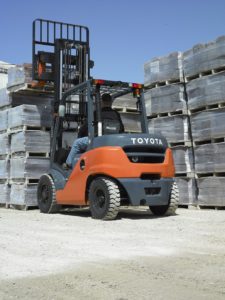
- Surface cracks. There should be no cracks anywhere on the forks. Check the heel area and welds carefully.
- Blade and shank angle. Check the angle between the blade’s upper face and the shank’s front face. If the angle exceeds 93% the forks must be replaced.
- Straightness. They must be replaced if the forks are bent more than 0.5% of the corresponding blade length or shank height.
- Fork tip height. Forklift blades should be the same height. They should be checked if there is a noticeable difference between the tips. If excessive, the forks should be replaced.
- Positioning lock. If the positioning lock or other fork retention device malfunctions, it should be checked carefully before continuing use. These types of pins lock the fork to the carriage to prevent the fork from sliding off.
- Fork thickness. Metal on forks wears down over time. A 10% decrease in fork thickness reduces load capacity by 20%. Use forklift calipers to measure the thickness of the fork blade, heel, and hook.
- Capacity stamp. The capacity stamps should always be visible.
Forklift forks should be inspected at least once a year by a qualified service technician. Our experienced forklift technicians are available to inspect your forklifts and forks to ensure efficient and safe work conditions. Contact us to set up a service appointment today!
Have You Checked Your Forklift Chains Lately?
Forklift chains are a necessary and important feature of a forklift. They lift thousands of pounds of material, and failure in any part of the forklift chain can cause a safety issue for the operator and anyone nearby.
Inspecting forklift chains should be part of your forklift operator’s daily inspection. Here are ten common forklift chain problems and solutions:
- Problem: A worn contour is typically caused by normal wear on the sheave or abnormal wear from rubbing on the guides. Solution: To fix a worn contour caused by normal wear, replace the leaf chain when worn down 5 percent. If it is caused by abnormal wear, check the leaf chain alignment, or increase the clearance.
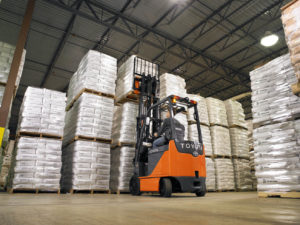
- Problem: Worn surfaces on outer plates or pinheads caused by misalignment and rubbing on the side flanges. Solution: Check the leaf chain alignment and correct the clearance as necessary.
- Problem: Tight joints caused by dirt or foreign substance packed in joints, or corrosion, rust, or bent pins. Solution: Clean and re-lubricate the leaf chain or replace it entirely.
- Problem: Missing parts. If your leaf chain is missing parts, it is usually because it was omitted in the original assembly. Solution: In this case, you need to replace the leaf chain completely.
- Problem: Abnormal protrusion or turned pins, usually caused by excessive internal friction caused by high loading and inadequate lubrication. Solution: Replace the leaf chain, improve lubrication, and eliminate overload conditions.
- Problem: Cracked plates from fatigue caused by loading beyond the chain’s capacity and endurance limit. Solution: Replace chain with leaf chain of larger dynamic capacity or eliminate high load conditions.
- Problem: Fractured plates in tension mode caused by high overload. Solution: Replace the leaf chain and correct the cause of the overload.
- Problem: Enlarged holes caused by high overload. Solution: Replace the leaf chain and correct the cause of the overload.
- Problem: Corrosion due to environment. Solution: Replace the leaf chain and protect it from a hostile environment.
- Problem: Worn leaf chain anchor bolt connecting pin caused by normal wear. Solution: Replace worn leaf chain components as necessary and always replace the components when fitting new leaf chains.
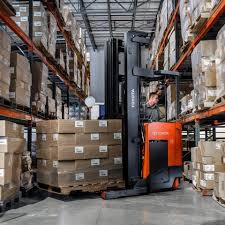 In a single-shift operation working on flat, even surfaces, chains can last 3 – 5 years. In more harsh environments, chains may need to be replaced much sooner. Even though inspecting forklift chains should be part of your forklift operator’s daily inspection, for safety reasons, it is necessary to schedule a professional assessment at least once a year.
In a single-shift operation working on flat, even surfaces, chains can last 3 – 5 years. In more harsh environments, chains may need to be replaced much sooner. Even though inspecting forklift chains should be part of your forklift operator’s daily inspection, for safety reasons, it is necessary to schedule a professional assessment at least once a year.
Our service associates are experts at finding and fixing forklift chain issues. Contact us to schedule a service appointment today!
Forklift Service During COVID-19
It’s probably an understatement to say the COVID-19 pandemic has thrown us all for a loop. One of the main discussion points at Toyota Material Handling Solutions is continuing to provide excellent forklift service while keeping everyone safe.
Our Safety Commitment
To carry on with our company’s well-known commitment to safety, we’re taking every measure to protect your employees’ health and ours during this pandemic. Besides donning gloves and masks, practicing social distancing, and disinfecting equipment, we train our technicians to take specific steps to perform service during the pandemic safely.
Six Safety Steps
To help alleviate any fears you might have about servicing your equipment during this time, we want to share the steps we take to keep you safe. Here are six areas our service technicians focus on to service your forklift fleet safely.
- Prevention: We instruct our associates to maintain excellent personal hygiene measures and stay home if they have any symptoms of COVID-19 or any other virus.
- Social distancing: We tell our associates to keep a six-foot distance from others and avoid group meetings or other gatherings.
- Disinfecting: Our technicians sanitize the equipment before and directly after performing service work, including spraying disinfectant, letting it sit for one minute, and wiping down all controls, covers, and doors.
- Communication: Our service department contacts you to determine a safe work area before your service appointment. When they arrive, our technicians comply with any required screening and section the desired work area with safety cones to ensure proper social distancing.
- Proper safety protocol: Our technicians perform personal hygiene measures before entering your facility and wear masks and gloves the entire time.
- Work order procedures: To complete necessary work orders and approvals while observing social distancing, our technicians print your name on the signature line and take a picture of you for identification purposes. If you prefer to sign the bill, we wipe down the phone before and after your signature while maintaining social distancing.
Your safety is our top priority. Call 800-794-5438 if you have questions regarding our COVID-19 safety procedures, or contact us to schedule a service appointment today.
